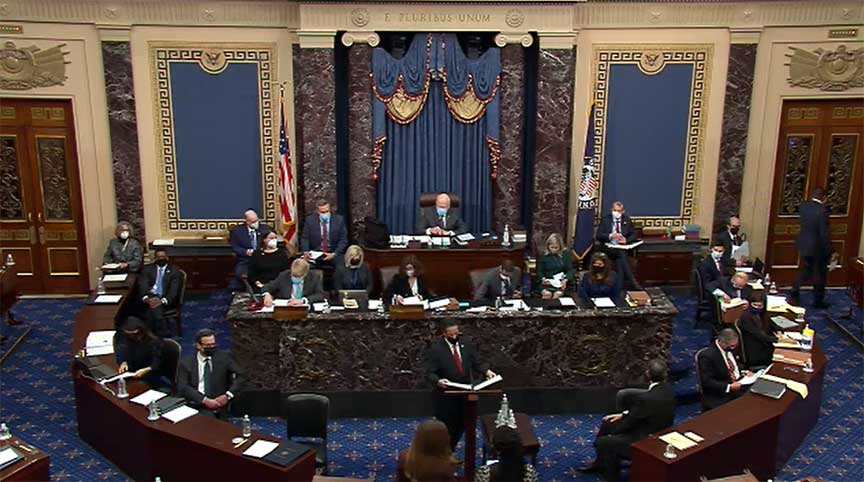Second Impeachment of Donald Trump

Senate Trial
On January 13, 2021 the House of Representatives voted to impeach President Trump, for incitement of an insurrection. This was the first time in history that a President was impeached twice. On February 9th his trial began in the Senate. It ended with a vote 57-43 to convict, but ten votes short of the 2/3 majority needed.
In the aftermath of the attack on the US Capital on January 6th Representatives David Cicillline, Ted Liue and Jamie Raskin introduced Article of Impeachment against then President Trump. The article which was eventually cosponsored by 218 House Members stated that the President had committed High Crimes and Misdemeanors by falsely claiming he won the election, trying to overturn the results of the elections and then incited a mob to march on the Capital and disrupt the counting of the electoral College Votes. The Full House voted to Approve the Articles of Impeachment on January 13, 2021 by a vote of 232-197. All House Democrats voted to impeach while 10 Republicans joined them. Four Republicans did not vote and 197 voted no.
On January 26th the House impeachment Managers led by Congressman Raskin the leader managers formally crossed the Capitol rotunda and read the impeachment to the Senate. The Senate pro temper Patrick Leahy was selected to preside over the trial after Supreme Court Chief Justice Roberts said since it was not a trial of a sitting President he did not have to pride over the trial.
Before the trial could begin Senator Rand Paul raised an point of order claiming it was not constitutional to put on trial a past President. The issue came to a vote and was defeated 55-43 with five Republican Senators voting with the Democrats.
The House Impeachment managers first defended the question of whether a former President could be put on trial, siting the cases that support that position. They also included a video presentation that highlighted the events of January 6th that all agreed was compelling. After the President’s lawyers argued that the trial violated the constitution. The Senate voted by a simple majority of 56-44 to continue the trial.
The House Impeachment managers then presented their case. Relaying heavily on videos of both Trumps speech and the actions of the attackers on the capital. The videos included many video scenes and audio tapes that had not been previously been seen or heard. One of the major themes of the managers beyond presenting the case that Trump had incited the insurrectionist, but also showed how Trump had encouraged the mob to kill Vice President Pence. The managers used almost all of their allotted 16 hours to present their case and independent observers all agreed that the House had made a powerful case.
The Trump defense team then gave a one day defense that was centered on the use of the word fight by Democratic's and thus try a whataboutism defense. They also tried to portray Trumps speech as protected speech under the 1st Amendment. By and large however the defenders relied on the fact that conviction which requires a 2/3 ’s vote to convict which meant 17 Republicans many of whom were afraid of being challenged in their next race by a die hard Trump supporters.
After both sides had presented their case Senators had a chance to ask questions. Lisa Murkowski together with Susan Collins asked when did Trump learn about the riot and what steps did he take to end it. Trumps lawyer Michael van der Veen responded by sayin that they did not know since the House had not done its job in investigating.
On February 13th the Senate voted in a surprise move to allow the calling of witnesses. The sudden decision was a result of an news article in which Republican Representative Jaime Herrera Beutler recalled a conversation with Representative Keven McCarthy who told her about a call made by Mccarthy to Trump while the riot was going on asking for help. The Presidents response was “that clearly the rioters cared more about his losing the election than McCarthy did” The Senate voted 55-45 to allow witnesses. Before witnesses could called a compromise was reached to enter into the record the account of the call, instead of calling witnesses. The statement included:
In my January 12 statement in support of the article of impeachment, I referenced a conversation House Minority Leader Kevin McCarthy relayed to me that he’d had with President Trump while the January 6 attack was ongoing. Here are the details: When McCarthy finally reached the president on January 6 and asked him to publicly and forcefully call off the riot, the president initially repeated the falsehood that it was antifa that had breached the Capitol. McCarthy refuted that and told the president that these were Trump supporters. That’s when, according to McCarthy, the president said: ‘Well, Kevin, I guess these people are more upset about the election than you are.' Since I publicly announced my decision to vote for impeachment, I have shared these details in countless conversations with constituents and colleagues, and multiple times through the media and other public forums.
After both sides had given their closing arguments the Senate the Senate voted 57-43 to convict ten short of the 2/3 needed to convict the ex-President. Seven Republicans joined all of the Senate Democrats in voting to convict.
 >
>